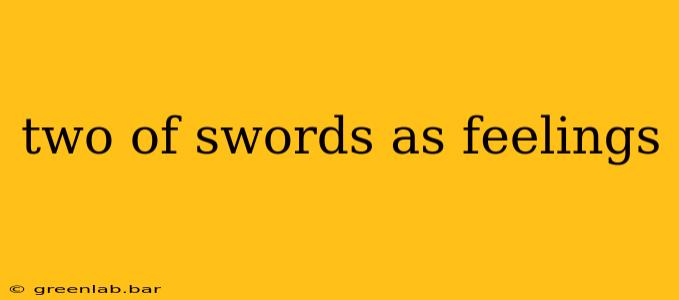The Two of Swords in tarot often depicts a scene of stillness—a figure blindfolded, holding two swords in a precarious balance. While visually serene, the card speaks volumes about internal conflict and the feelings associated with emotional blockage. Understanding the Two of Swords as feelings means delving into the complexities of avoidance, suppressed emotions, and the eventual necessity of confronting internal struggles.
The Core Feelings of the Two of Swords
The dominant feeling evoked by the Two of Swords is stagnation. This isn't merely inaction; it's a sense of being stuck, unable to move forward or make decisions because of conflicting emotions or beliefs. Think of it as being paralyzed by indecision, caught in a stalemate between two opposing forces within yourself. This can manifest as:
- Indecisiveness: The inability to choose between two paths, leading to frustrating delays and a sense of being overwhelmed.
- Avoidance: Consciously or unconsciously shutting down your feelings to avoid confronting difficult truths or making tough choices. This can involve ignoring problems, pretending everything is fine, or withdrawing from relationships.
- Suppressed Emotions: Bottling up your feelings, preventing healthy processing and potentially leading to emotional outbursts or physical manifestations of stress.
- Mental Fatigue: The constant internal struggle drains mental energy, leaving you feeling exhausted and unable to focus on other aspects of your life.
Beyond the Surface: Nuances of the Two of Swords Feelings
While stagnation is central, the Two of Swords encompasses a wider spectrum of feelings, including:
- Inner Conflict: A tug-of-war between your head and your heart, logic versus emotion, or two opposing desires. This can create internal turmoil and make even simple decisions feel incredibly difficult.
- Tension: A palpable sense of pressure, as if you're holding your breath, waiting for something to break. This can manifest as physical tension in the shoulders, neck, or jaw.
- Unease: A lingering feeling of discomfort or disquiet, even when outwardly everything seems calm. This is a subconscious awareness of the unresolved conflict within.
- Deception: The blindfold often symbolizes self-deception or a refusal to see the truth, even when it's staring you in the face. This can manifest as denial, rationalization, or minimizing the significance of the problem.
Moving Past Stagnation: Finding Clarity After the Two of Swords
The Two of Swords, while challenging, is not inherently negative. It serves as a wake-up call, highlighting the need for internal reconciliation and clarity. Overcoming the feelings associated with this card requires:
- Self-Reflection: Taking time for introspection to understand the source of the conflict and the emotions involved. Journaling, meditation, or mindful self-inquiry can be helpful.
- Honest Assessment: Facing the uncomfortable truths, even if it's painful. Avoidance only prolongs the stagnation.
- Seeking Balance: Finding a way to integrate the opposing forces within you, rather than suppressing one in favor of the other. Compromise and acceptance are key.
- Making a Decision: Even if it's not perfect, choosing a path and committing to it is crucial to breaking the cycle of indecision. Remember, action often leads to more clarity than inaction.
The Two of Swords as feelings represents a critical juncture. While the stillness can feel overwhelming, it's a catalyst for growth and self-discovery. By acknowledging the complexities of the emotions involved and taking proactive steps toward resolution, you can move beyond stagnation and embrace a future of greater clarity and emotional well-being.

